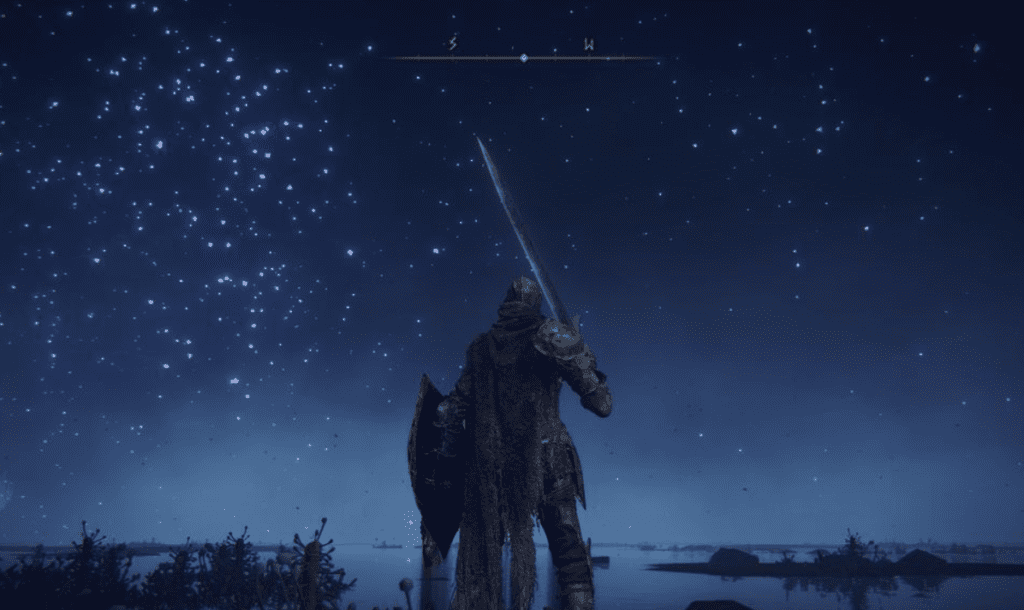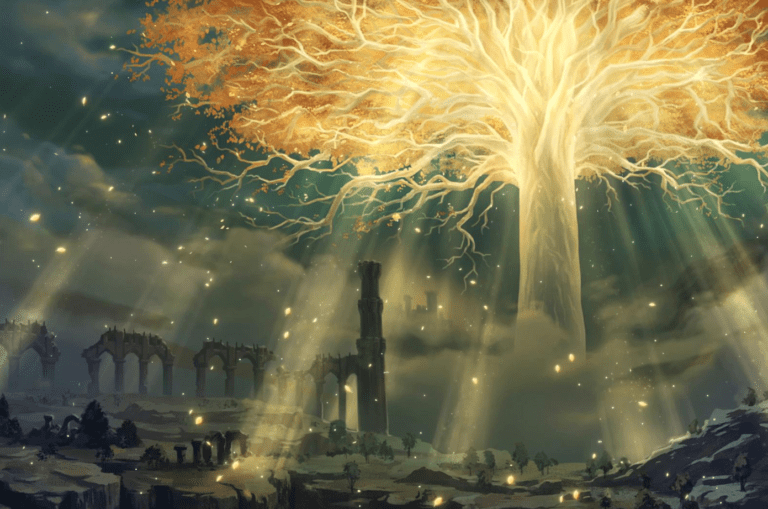Have you ever looked at the Elden Tree and thought it looked more like a Mushroom than a Tree? Well, you are not alone here! Today, we are going to explore a unique perspective on the game’s lore that might just change the way you see the Lands Between. Let’s embark on a journey to understand “Elden Ring Mushroom Theory Explained – Story and Lore of Elden Ring.”
Before you dive in, give a look at another Lore/Story of Elden Ring: Lore/Story of all Elden Ring DLC Main Bosses in Shadow of the Erdtree
The Major Influences of Elden Ring

In Elden Ring, we can identify three major influences:
- Mythological
- Alchemical and Occult
- Botanical
While each of these elements plays a significant role, today we will focus on a unique and intriguing aspect – mushrooms.
History and Lore: A World of Mushrooms – Erdtree Secrets
The history of the Lands Between is written by the victors, leading to many civilizations being buried beneath the decay of time, much like mushrooms rising from the dead.
The entire world of Elden Ring is built upon the decaying corpses of primordial giants, a clear hint towards the fungal theme, and ultimately giving life to the Mushroom Theory of Elden Ring.
Did you know? The Melania’s Rot looks like a real-life Fungal Bloom. Another coincidence here.
The Erdtree: More Than Just a Tree
The Erdtree has been a subject of debate within the community. Is it a single magnificent golden tree, or is it something else entirely?
Upon closer inspection, especially at the Elden Throne, it becomes evident that the Erdtree consists of a regular tree of wood coated in gold.

At the canopy, you can observe a battle between the wood and the gold, with golden tendrils taking over the dead wooden tree beneath.
Slime Molds and the Erd Tree
There’s an interesting real-life parallel with slime molds, which feed on and decompose dead trees, even sharing a golden color similar to the Erd Tree.
Despite being amoebas rather than fungi, slime molds share the same principle of feeding off the dead and emitting spores, much like the Elden Beast, which sustains itself from the dead in the Lands Between.
The Golden Seed and Mushroom Imagery

The Golden Seed’s description suggests a behavior similar to spores, scattered across the Lands Between after the Elden Ring was shattered.
The glowing mushrooms in the Lands Between share the same golden hue as the Erd Tree, suggesting a deliberate choice by the game’s designers to connect these elements.
All of this doesn’t mean the game made the Erdtree a type of mold, fungi, or mushroom specifically. No, that is not the case, but we are digging into the theme behind the game’s development, which is quite similar to our Mushroom theory.
The Two Fingers and Dead Man’s Fingers – Finger Mushroom Theory

In the new Elden Ring DLC, the lore surrounding the two fingers has been expanded. They resemble a real-life mushroom called Dead Man’s Fingers.
The new item, Finger Mimic, confirms this connection. These mushrooms called the stillborn of the two fingers, are used to induce hallucinations and reinforce the mushroom theme in the game’s lore.
Elden Ring DLC has an amazing twist, do check out more lore guide for explanation: Did Messmer Kill Melina – Elden Ring DLC Melina and Messmer Lore Explained
The Role of Mushrooms in Ecosystems
Mushrooms act as messengers in ecosystems, sending and receiving signals through the Great Mycelial Network. This network is akin to the roots of the Erd Tree, which touch every part of the game world, spreading life and death.
The two fingers, stationed atop the Divine Towers, are connected to the Erd Tree, further cementing their role as intermediaries.
Metyr and the Lesser Finger Creepers – The Nox

The Elden Ring DLC introduces Metyr, the mother of the two fingers, who now gives birth to the lesser and unpowerful Finger Creepers instead of the two fingers.
This change is believed to be due to an injury inflicted by the Nox using the Fingerslayer Blade, highlighting the theme of injury and decay.
Spores and the False Night Sky

The false night sky in the Land of Shadow is revealed to be filled with spores rather than stars. These spores infect the vegetation, creating a landscape covered in white mycelium, similar to the behavior of slime molds in real life. This is where the Elden Ring DLC Mushroom Theory and Story gets real life.

Also, there is a slime mold called myxogastria that looks exactly like this in Elden Ring, suggesting the developers took the idea from these real-life mushrooms.
All of this suggests that the greater will manifests its manipulation through the use of mushroom.
The Ancestral Worshippers

The Ancestral Worshippers in the DLC worship the cycle of decomposition and growth from death.
This theme is reflected in the Ancestor Spirit’s horn, which symbolizes new life growing from death, a fundamental concept in Elden Ring’s lore.
The Living Jars and Potentates

In the DLC, the true nature of the Living Jars is revealed. They contain a mix of bodies and mushrooms, used to build structures and sustain life.
The Red Flesh and White Flesh Mushrooms found in the Land of Shadow serve as pot innards, further emphasizing the theme of decomposition and renewal.
The Spiral Tower and Divine Gate

Enir Illim, the Spiral Tower, is built from bodies and serves as the path to divinity. The power of Godhood, as seen with Merika and Miquella, is fueled by the bodies within the tower.
Miquella’s Circlet of Light, left behind after his defeat, boosts intelligence, faith, and arcane, symbolizing the power gained from death.
Finger Mimic and Finger Nostrum

The Finger Mimic mushroom is used to craft the Finger Nostrum, which boosts the mind, intelligence, faith, and arcane at the cost of gradual HP loss.
This item symbolizes the transformation into fingers, echoing the theme of decomposition and power.
In short, the Nostrum will give you the same effect as Miquella’s Circulet. That is why when you use the Nostrum it does give you a boost, but also takes away your life slowly, which in short means you are decomposing.
The Greater Will and Mushroom Imagery
The Greater Will manifests its influence through mushrooms and decomposition. This is seen in various aspects of the game, from the Nox’s failed attempts to replicate divinity to the Helig Tree watered by Miquella’s blood. The fundamental law of power in the Lands Between is clear: from death, power arises.
Are you not satisfied by the Lore and Story of Elden Ring matching Mushrooms and that Erdtree might actually be a Mushroom? Well, there is more.
Ranii and Mushroom Theory in Elden Ring

Ranii in Elden Ring matches a specific type of mashroom. Also, this matches the death, divinity, and life theme from the Mushroom. Since she would be to become the Lord at her age, she has to die, killing herself, and decomposing her body in order to gain strength.
Godwyn and the Elden Ring Mushroom Theory

When Godwyn died, he literally became a fungus on the Erdtree. Quite strange similarities, huh? He has the same top, the environment, and the theme as a specific mushroom that grows on the trees, or around it.
Conclusion
Understanding the mushroom imagery in Elden Ring helps us grasp the deeper themes of the game. From the Erdtree to the two fingers, and the Ancestral Worshippers to the Living Jars, the cycle of decomposition and renewal is a core element of the game’s lore. By embracing this perspective, we can appreciate the intricate and unique world of Elden Ring even more.
Well, there is much more here like the spirit people who can’t die, looking at the sky, the scarlet rot itself, and so on. But, you eventually get the point that everything here is somehow pointing towards Mushrooms, giving like to the Elden Ring Mushroom Theory in general.
Keep exploring, Tarnished, and may your journey through the Lands Between be ever more enlightening!




